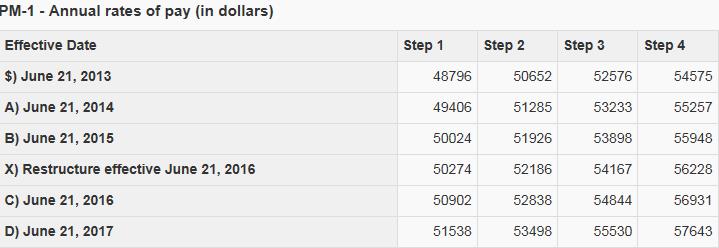Increments - General Information
A pay increment increases your pay to the next highest horizontal pay rate on the pay scale until the maximum rate for the position is reached. The pay increment period is set out in your collective agreement. If it does not specify a period of time, the pay increment period defaults to 12 months.
EXAMPLE:

Long Description
Annual rates of pay for PM-1 (in dollars)
Effective date of June 21, 2013: Step 1 ($48796), Step 2 ($50652), Step 3 ($52576), Step 4 ($54575);
Effective date of June 21, 2014: Step 1 ($49406), Step 2 ($51285), Step 3 ($53233), Step 4 ($55257);
Effective date of June 21, 2015: Step 1 ($50024), Step 2 ($51926), Step 3 ($53898), Step 4 ($55948);
Restructure effective June 21, 2016: Step 1 ($50274), Step 2 ($52186), Step 3 ($54167), Step 4 ($56228);
Effective date of June 21, 2016: Step 1 ($50902), Step 2 ($52838), Step 3 ($54844), Step 4 ($56931)
Effective date of June 21, 2017: Step 1 ($51538), Step 2 ($53498); Step 3 ($55530), Step 4 ($57643)
Links:
Promotions:
A new pay increment date will be set to correspond with the date of your promotion as per your collective agreement or terms and conditions of employment.
Deployment (transfer):
Generally, upon deployment to a new position that has the same increment period as the former position, the pay increment date will remain the same. The date will, however, change if you are a seasonal employee or are appointed to a position with a different increment period (that is, the increment period is shorter or longer).
Acting:
While acting in a position you will continue to receive pay increments at your substantive level. As a result, your acting pay rate will be recalculated and adjusted accordingly. If the recalculated rate is less than your existing acting pay, you will continue to receive the higher rate. You may also be entitled to receive a pay increment at the acting level. This will depend on where your substantive position lies on the pay rate scale.
Term Employee:
An employee appointed to a term position receives and increment after reaching 52 weeks of cumulative service at the same group and level.
How the Pay Centre treats a pay increment and a revision due on the same date:
When a pay increment and a pay revision are effective on the same date, the pay increment will apply first, followed by the pay revision.
How the Pay Centre knows when your pay increment is due:
The Phoenix pay system is automated to apply pay increments when they are due in accordance with the collective agreements.
How you will be notified about a pay increment rejection:
Your manager or the individual with delegated authority will notify you at least two weeks, but not more than six weeks, before the due date if your pay increment is going to be denied.
Pay increment dates following a denial:
If your pay increment was denied, you will be eligible for a pay increment on the date that the next increment would become due. Your manager or the individual with delegated authority may request payment of the increment on the first day of any month before that date.
How leave without pay changes your pay increment date:
Collective agreements and terms and conditions of employment found in the relevant authorities provide for various types of leave without pay. Consult the appropriate terms governing your specific type of leave to determine how your absence may affect your pay increment date. Leave which is for a period of more than three (3) months shall not be counted for pay increment purposes with the exception of leave due to Illness, Maternity or Parental.
How your new pay increment date is set if you receive a promotion within one year of lay-off:
A new pay increment date will be set as per your collective agreement or terms and conditions of employment. The increment date will align with the date of your promotion.
How your new pay increment date is set if you are deployed (transferred) within one year of lay-off:
If you are appointed within one year of a lay-off, the period between the last pay increment date and the lay-off date is used to determine the new pay increment date.